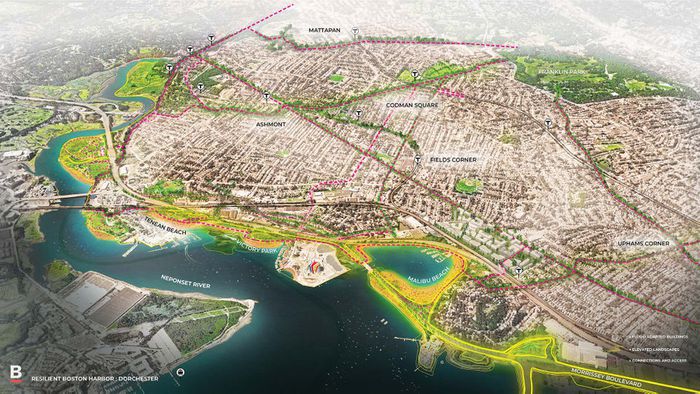Rising sea levels will obliterate entire cities and render homes, buildings and roads unusable. Here are the key design strategies to adapt to a phenomenon that now seems unstoppable.
The climate and oceans have warmed beyond the point of no return. According to the oceanographer John Englander and many other scholars there is nothing we can do to stop the melting of the Greenland and Antarctic ice sheets.

Sea level rise is now inevitable. By the end of this century, sea levels could be 3 meters higher than they are today.
The impact on society of this sea level rise will be immense.
The shoreline as we know it will be completely remodeled, flooding tens of thousands of coastal communities around the world and rendering millions of homes, buildings, roads and other infrastructure useless or unusable.
Some coastal cities could see floods every day within less than 30 years. Cities like Miami, New Orleans, Copenhagen and Shanghai could be virtually canceled.
“It's pretty bad,” Englander says. “But it's also a design challenge.”
We need to start designing right away
We need to start planning and designing today for this massive upheaval. Engineers, planners, architects and policy makers, financiers and insurance companies must mobilize.
Once you understand that we could have meters of rise within a few decades, you realize that you can't wait for the water to arrive.
“We need to change the infrastructure, where the ports and airports are located and how coastal development happens,” Englander says. “We are thinking small at the moment. We are installing pumps and raising the roads 50 centimeters at a time. We have to think big. “
Englander offers a number of strategies for rethinking coastal communities in the near future with much higher seas.

Accept the inevitability of sea level rise
Sea rise is already happening and will rise much faster in the decades to come, Englander says. “Sea level has risen by about 20 centimeters over the last century. And this happened quite gradually, to the point that we didn't really notice. But it's accelerating. Over the past 30 years it has almost doubled every decade. We are already in a new reality."
Rising ocean temperatures mean melting will continue to increase. THE changes in the Gulf Stream they are another sign of the changes taking place.
“The planet has already warmed by one degree centigrade. We're trying to limit warming to another degree Celsius and most scientists are starting to doubt whether that's possible,” Englander says. “But even if we could comply with the Paris agreements we will still have a rise in sea levels. The fact that sea level rise is unstoppable is the first thing we must accept."

Thinking about the hinterland and rethinking the coast
Several meters of sea level rise will put parts of many cities under water.
Recognizing this and mapping the areas most likely to be affected will help governments and planners understand if and how existing development will have to adapt. For some places, this may mean elevating structures.
For others, it may mean abandoning entire parts of cities and retraining on more internal and higher altitudes. Relocations that could be difficult, especially for those that could already be marginalized.
“We need to move some things further inland, we need to move some things higher up, put some things on floats. We have to get very creative,” Englander says. “The good news is that we have decades to start adapting. But it means a fundamental rethink of our infrastructure.”
Much more than roads and power grids
Coastal infrastructure is vital to many national economies.
We cannot abandon the coasts, in any case. We must guard these and build the next coasts. They are used for ports, fishing, hydroelectric energy and the cooling of industrial plants.
For this reason, as the seas rise, it will be essential to redesign and rethink these coastal infrastructures.
Plans to manage rising seas in the coming years: the case of Boston
Englander says governments, city planners and developers need to think not just about sea level rise over the next 20 or 30 years, but about what might happen over the next century. There is a functional life of 100 years to be considered for large infrastructures such as highways, viaducts, fortifications, subways.
The same long duration applies to cities, and planners are starting to take sea level rise into account when outlining long-term plans.

Le design guidelines in the city of Boston, for example, already take into account up to 1 meters of sea level rise today. It's probably the most far-sighted plan at the moment. Among the "forecasting" projects there are even bold scenarios in which some roads could become navigable canals.
Beyond Boston, the example of Singapore (at the forefront) is also admirable also for other things), where the government has demanded that the construction of a new airport terminal be at least 5 meters above sea level.
Design for adaptation
Adaptation and reconstruction efforts don't have to happen all at once. Englander suggests engineers and builders think about the concept of adaptive engineering or design a project today so that it can be easily modified or adapted even many years from now.
Let's take a new bridge, for example. Given sea level rise in the coming decades, that bridge would likely be designed to accommodate at least 1 feet of potential rise. We need to build the foundation now so that it can support a taller structure.
Also because the cost of raising a building by one and a half meters is much lower than that of raising it by three meters.
If designed for later adaptation, these projects could be adapted when the pace and scale of sea level rise requires it. Because whether we are ready or not, the sea level will significantly change what we now know as the coast.
The rising seas will not stop. There is no alternative to melting ice and rising sea levels.


